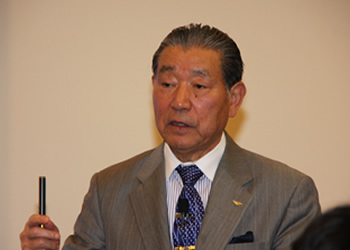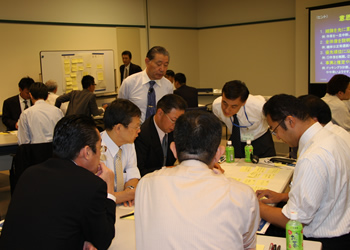|
|
 |
| The 19th Managers’ Seminar was held at the Mita NN Hall in Tokyo’s Minato Ward over the course of two days, from October 29th (Thursday) to the 30th (Friday), and was attended by 23 mid-level managers from member organizations. The aim of this seminar was to offer content which will be of use to participants in actively establishing and building a safety culture, and towards this end, participants were given a chance to experience CRM (Crew Resource Management) training, which is utilized in such fields as aviation. |

Professor Akira Ishibashi, Tohoku University Graduate School of Engineering, Department of Management Science and Technology
|
(1) Lecture:
“Training Techniques for a New Era – Experiencing CRM Training: A Proven Technique from the Airline Industry –” Professor Akira Ishibashi, Tohoku University Graduate School of Engineering, Department of Management Science and Technology
Professor Akira Ishibashi of the Tohoku University Graduate School of Engineering, Department of Management Science and Technology was invited to come and introduce participants to CRM training.
CRM stands for “Crew Resource Management” and was developed by the aviation industry. The idea underlying this training style is “to achieve flight safety by fostering greater teamwork and optimal decision-making utilizing all of the resources (i.e., people, machines and information) available in a plane’s cockpit”, hence the acronym “CRM”.
Research into and development of CRM training goes back roughly 30 years and was very much motivated by the increasing incidence of CFIT (Controlled Flight into Terrain) accidents that were accompanying aircraft development. CFIT accidents are accidents which are not the result of some serious aircraft malfunction, and their high frequency of occurrence made addressing the human factors underlying them a top priority. Major examples of CFIT accidents include the crash of a TriStar jet in Miami, the crash of a United Airlines plane which had run out of fuel, and the midair collision of two jumbo jets over Tenerife airport. Analysis of these CFIT accidents combined with the results of other research found that the majority of accidents were the result of “inappropriate decision-making” and “loss of situational awareness” by veteran pilots. Getting veteran pilots to be aware of the importance of safety, therefore, became an urgent issue, and CRM training was developed in order to foster a “culture of awareness”.
An effective method for cultivating such a culture of awareness was to provide pilots with a certain amount of information and then have them discuss it. By incorporating these pilots’ wealth of experience into the course of discussions, it was made clear how important factors such as communication are. If such an awareness and thinking can be imparted, it will ultimately reflect itself in people’s actions.
CRM training involves training participants in techniques relating to the five elements of communication, decision making, teamwork, situational awareness and workload adjustment. Each of these elements is further broken down into three smaller elements for a total of 15 CRM techniques.
By implementing these CRM techniques, the aviation industry has successfully improved its safety record. One example of this success is the 1989 crash of a DC-10 in Sioux City in the United States. The accident was the result of a total failure of the plane’s hydraulic system – the same as what caused the crash of a Japan Airline’s flight in 1985. However, thanks to the implementation of CRM techniques, more than half of the crew and passengers survived.
Other fields, including maritime shipping, air traffic control, medicine, manufacturing and railroads, are currently introducing CRM into their operations and are seeing definite results. |
(2): Trying CRM Training (Activity)

During the CRM training |
Following the first session, Professor Akira Ishibashi, head of the Tohoku University Graduate School of Engineering, Department of Management Science and Technology led the participants in a CRM training practice session which inlcuded
・CRM training (communication)
・Case studies of aviation accidents
・CRM training (decision making)
・CRM video exercise (communication)
・CRM video exercise (decision making)
|
| The following impressions were among those expressed in the questionnaires given after the seminar:
・The lecture, with its use of video, and the video exercise, which was well-tailored to real-life situations, were easy to understand.
・CRM training would work in my workplace, which needs teamwork and the five elements of CRM.
・Listening to the group presentations made me aware of areas where I am lacking.
・I benefited from having these nebulous concepts brought home to me in a concrete way.
・Our industry is one where “awareness and communication” are indispensible to all aspects of work; so I hope that everyone is reminded of their importance. |
|
|







